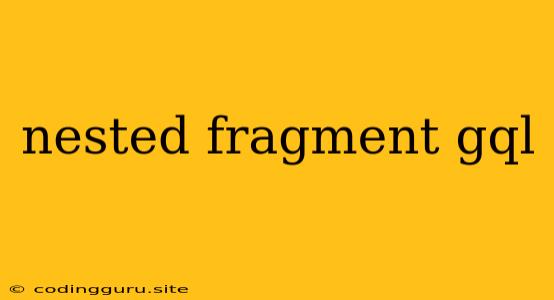Understanding Nested Fragments in GraphQL: A Comprehensive Guide
GraphQL, with its flexible query structure, allows developers to fetch precisely the data they need. However, as your application grows, the complexity of queries can increase, leading to redundancy and inefficiency. This is where nested fragments come in.
Nested fragments offer a powerful mechanism to structure your GraphQL queries, making them more readable, maintainable, and efficient. This guide will delve into the intricacies of nested fragments, providing you with a thorough understanding of how they work and how to effectively utilize them in your GraphQL applications.
What are Nested Fragments?
Fragments in GraphQL are reusable query units that define a specific set of fields to be retrieved. Nested fragments, as the name suggests, are fragments that are defined within other fragments. This allows you to break down your query structure into smaller, more manageable parts, reducing redundancy and improving code organization.
Why Use Nested Fragments?
-
Improved Code Reusability: Nested fragments allow you to define common data patterns once and reuse them across multiple queries. This reduces redundancy and improves code maintainability.
-
Enhanced Readability: By breaking down complex queries into smaller fragments, you can make your queries more readable and easier to understand.
-
Efficient Data Fetching: Nested fragments enable you to fetch only the specific data you need, avoiding unnecessary data retrieval and improving performance.
How do Nested Fragments Work?
Let's illustrate with an example:
fragment AuthorData on Author {
id
name
books {
id
title
}
}
fragment BookDetails on Book {
id
title
author {
...AuthorData
}
}
query GetBookDetails {
book(id: 1) {
...BookDetails
}
}
In this example, we have two fragments: AuthorData and BookDetails. AuthorData defines the fields to be retrieved for an author, while BookDetails defines the fields for a book, including the author's data using the nested AuthorData fragment.
The final query GetBookDetails utilizes the BookDetails fragment, effectively combining the fields defined in both BookDetails and AuthorData to retrieve a complete set of information about the book and its author.
Advantages of Using Nested Fragments
-
Modular Design: Nested fragments promote modularity by separating query logic into smaller, self-contained units, enhancing code organization and maintainability.
-
Efficient Data Retrieval: By fetching only the required data, nested fragments minimize unnecessary data retrieval, optimizing network traffic and improving application performance.
-
Reduced Code Duplication: Reusing fragments across multiple queries eliminates code repetition, leading to more concise and maintainable codebases.
Common Use Cases for Nested Fragments
-
Retrieving Related Data: When fetching data with relationships, nested fragments can be used to efficiently retrieve related data without repeating the query structure.
-
Complex Data Structures: For queries involving complex data structures, nested fragments can break down the query logic into smaller, more manageable parts, improving readability and maintainability.
-
Reusable Data Patterns: Nested fragments can be used to encapsulate common data patterns, allowing for efficient data retrieval in various parts of your application.
Tips for Using Nested Fragments Effectively
-
Keep Fragments Concise: Aim to create small, focused fragments that represent specific data sets or functionalities. This ensures modularity and promotes reusability.
-
Naming Conventions: Use clear and descriptive names for your fragments to reflect their purpose and contents.
-
Document Your Fragments: Provide documentation for each fragment, explaining its purpose, data structure, and intended usage.
-
Organize Your Fragments: Structure your fragments into logical groups or files to improve organization and maintainability.
Conclusion
Nested fragments are a powerful feature in GraphQL that enables you to structure complex queries in a more organized and efficient way. By leveraging the benefits of reusability, modularity, and efficiency, nested fragments can significantly enhance your GraphQL applications, making them more robust, maintainable, and performant.
